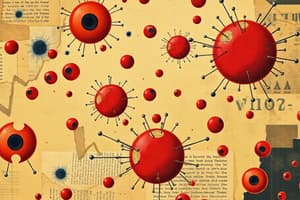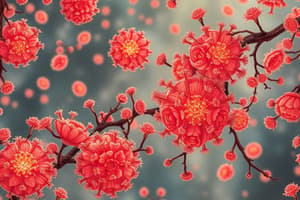Podcast
Questions and Answers
What is the primary reason for reactive lymphocytosis?
What is the primary reason for reactive lymphocytosis?
- Infection or inflammation (correct)
- Presence of a malignant tumor
- Genetic mutation
- Autoimmune disorder
Which condition is NOT typically associated with reactive lymphocytosis?
Which condition is NOT typically associated with reactive lymphocytosis?
- Infectious mononucleosis
- Cytomegalovirus infection
- Chronic lymphocytic leukemia (correct)
- Toxoplasmosis
A low NAP score in adults indicates what about the lymphocyte levels?
A low NAP score in adults indicates what about the lymphocyte levels?
- Low levels of lymphocytes (correct)
- Unreactive lymphocytes
- Normal lymphocyte levels
- High levels of activated lymphocytes
What morphological feature characterizes reactive lymphocytes?
What morphological feature characterizes reactive lymphocytes?
What defines lymphocytopenia?
What defines lymphocytopenia?
What is defined as an increase in circulating neutrophils in adults?
What is defined as an increase in circulating neutrophils in adults?
Which of the following is NOT a common etiology associated with neutrophilia?
Which of the following is NOT a common etiology associated with neutrophilia?
What is a critical peripheral blood finding in neutrophilia?
What is a critical peripheral blood finding in neutrophilia?
In which condition might you observe toxic granulation in neutrophils?
In which condition might you observe toxic granulation in neutrophils?
What level of leukocyte alkaline phosphatase score indicates neutrophilia?
What level of leukocyte alkaline phosphatase score indicates neutrophilia?
Which term describes a significant increase in white blood cell count that can mimic leukemia?
Which term describes a significant increase in white blood cell count that can mimic leukemia?
What is a common mechanism leading to neutrophilia?
What is a common mechanism leading to neutrophilia?
Which condition would most likely increase neutrophil counts due to physical exertion?
Which condition would most likely increase neutrophil counts due to physical exertion?
Flashcards
Neutrophilia
Neutrophilia
Increased number of neutrophils in the blood (above normal levels).
Normal neutrophil count
Normal neutrophil count
2000-7000 cells/µL in adults.
Causes of Neutrophilia
Causes of Neutrophilia
Infection, inflammation, injury, malignancy, certain medications, metabolic conditions, and post-splenectomy.
Leukemoid Reaction
Leukemoid Reaction
Signup and view all the flashcards
Toxic Granulation
Toxic Granulation
Signup and view all the flashcards
Neutrophilic Left Shift
Neutrophilic Left Shift
Signup and view all the flashcards
Neutrophilic Leukemoid Reaction
Neutrophilic Leukemoid Reaction
Signup and view all the flashcards
Reactive Lymphocytosis
Reactive Lymphocytosis
Signup and view all the flashcards
Reactive Lymphocytes
Reactive Lymphocytes
Signup and view all the flashcards
Toxic Granulation, Döhle Bodies, and Vacuolation
Toxic Granulation, Döhle Bodies, and Vacuolation
Signup and view all the flashcards
Lymphocytes
Lymphocytes
Signup and view all the flashcards
Lymphocytopenia
Lymphocytopenia
Signup and view all the flashcards
Causes of Reactive Lymphocytosis
Causes of Reactive Lymphocytosis
Signup and view all the flashcards
Study Notes
Blood Cell Abnormalities
- Blood cells have different roles: Red Blood Cells (Erythrocytes) carry oxygen and carbon dioxide, White Blood Cells (Leukocytes) fight infections, and Platelets (Thrombocytes) help with blood clotting.
- Abnormalities in blood cells can lead to various conditions.
- WBC disorders can be quantitative or qualitative.
Quantitative WBC Disorders
- Quantitative refers to the number of WBCs.
- Increased WBC count (neutrophilia) is often associated with infections, inflammation, injury, or certain cancers.
- A decrease in WBC count (neutropenia) can be due to inherited conditions, medications, or other diseases.
- Normal neutrophil count is 2000-7000 cells/uL.
- Increased in circulating neutrophils (adults) is usually greater than 7.5x109/L; rarely >3000/pL.
- Mechanisms for neutrophilia include increased bone marrow production, release, and egress from bone marrow storage.
- Peripheral blood findings for neutrophilia include a left shift (bands, metamyelocytes, myelocytes), toxic changes (granulation, bodies), and vacuolation.
- Neutrophilic leukemoid reaction mimics leukemia but is usually due to infection.
- Normal basophil count is up to 100 cells/µL.
- Increased (basophilia) is linked to hypersensitivity reactions, chronic myeloid leukemia, or other diseases.
- Normal lymphocytes are 1000-3500 cells/µL (adults).
- Increase in circulating lymphocytes (>4.0x109/L in adults) is linked with infection.
- Decreased lymphocytes (<2000/pL in children, <1000/µL in adults) is associated with various conditions, including systemic lupus erythematosus, steroid therapy, immune deficiencies, malnutrition, infections, and others.
- Normal monocyte count is up to 1000 cells/µL.
- Increased (monocytosis) can be due to chronic infections, recovery from acute infections, and collagen vascular diseases.
Qualitative WBC Disorders
- Qualitative refers to the structure and function of the WBCs.
- Qualitative disorders often involve inherited mutations affecting blood cell production or function.
- Examples include Alder-Reilly anomaly, May-Hegglin anomaly, Chédiak-Higashi syndrome, and chronic granulomatous disease.
- These disorders can be associated with problems in degrading or accumulating substances within the cells.
- Peripheral blood findings for qualitative disorders can include abnormalities in the size, shape, and granule characteristics.
Peripheral Blood Findings
- Various abnormalities in blood cells' appearance can indicate issues with their function or development. Specific abnormalities in these findings include inclusions, abnormal morphology, and abnormal counts.
Blood Disorders - Additional Information
- Gaucher disease, Niemann-Pick disease, and sea-blue histiocytosis are examples of qualitative disorders. Various other conditions lead to various types of blood cell abnormalities.
- Some blood disorders are associated with certain cancers and conditions. This includes various leukemias.
- Testing for blood disorders often involves checking for certain proteins or enzymes. For example, a nitroblue tetrazolium (NBT) test is used to assess oxidative burst.
Specific Types of Leukemia
- The FAB classification system helps categorize acute myeloid leukemia (AML) into subtypes. There are different subtypes and classifications with various abnormalites leading to corresponding diagnoses. This system uses morphology.
Studying That Suits You
Use AI to generate personalized quizzes and flashcards to suit your learning preferences.




